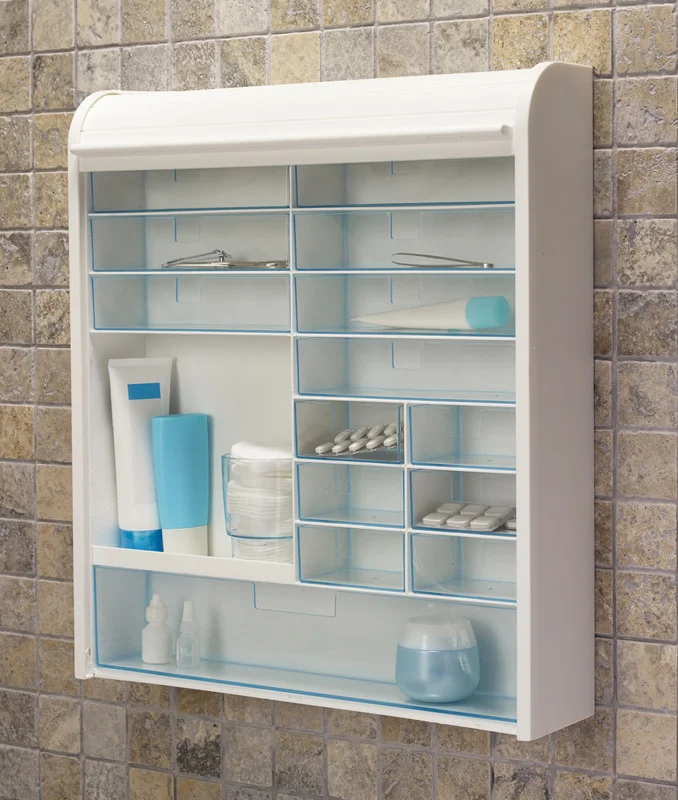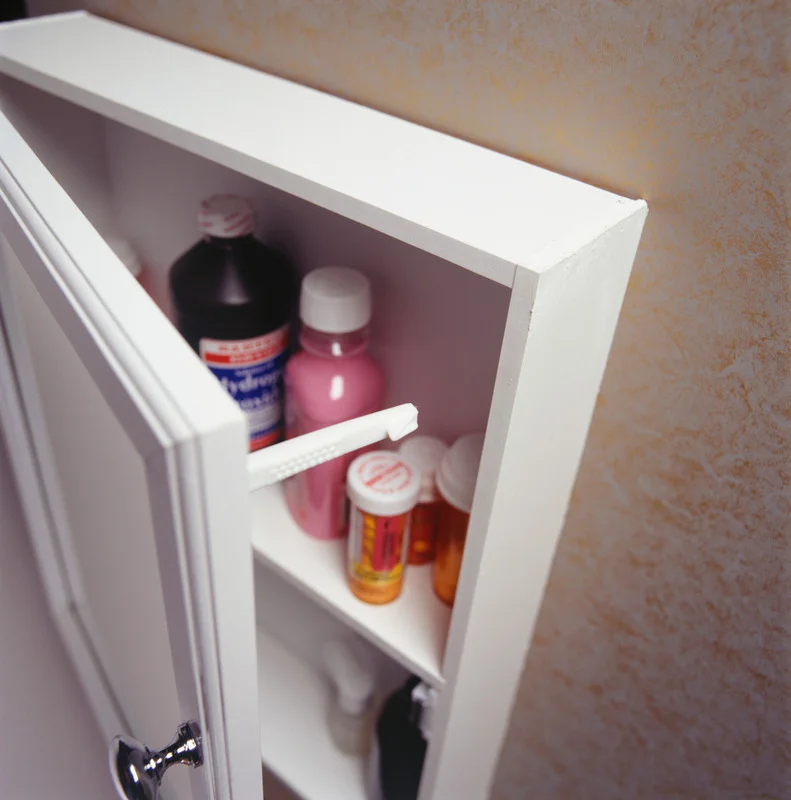A messy medication cupboard may be a major hassle, especially if you or a family member is sick. Expired bottles and half-empty prescriptions can clutter the area, making it harder to locate what you need. Do you wish you had an organization in place to keep things organized and available? You are not alone! We’ll show you how to organize your medicine cabinet in a way that works and makes you feel less stressed.

What You’ll Need
- Cleaning cloths or wipes
- All-purpose cleaner
- Labels
- Storage bins or containers
- A notepad for jotting down any items you need to restock
- Under-shelf storage racks
- Catch-all tray or basket
- Sorting trays or dividers
- Lock box or secure storage (for sensitive items)
How to Organize Medicine Cabinet?
Okay, let’s get started with your medicine cabinet makeover! Follow these instructions step-by-step to group the majority of your belongings, paying special attention to the ones that everyone uses.
Remove Everything
Get a new perspective on your belongings and their proper storage by starting afresh. Start by taking everything out of the medicine cabinet. Separate all of the items and set them on a surrounding surface. By providing a blank slate, this will make it easier for you to identify the things you should retain.
Wipe Down the Cabinet
Since the cabinet is empty right now, it’s a great time to clean it. A light all-purpose cleaner and a damp wash cloth are all you’ll need. This will make sure that your newly organized place starts out clean.
Toss Expired Products
Before you rush to put every bottle back in your cabinet, keep in mind that the purpose of this activity is to organize, not just clean. Medications, toiletries, and first-aid items have a shelf life, so don’t keep them “just in case.” Recycle or properly rid of these stuff to create way for the necessities. You may also find things that have just been misplaced or would be better stored elsewhere, such as hair accessories and shampoo.

How to Safely Dispose of Medicine
Make sure you properly dispose of any drugs you are dumping. Many shops and local governments have special programs or places where you can bring old or unwanted medicines to get rid of them. If not, dispose of drugs in a sealed bag or container in the garbage. Most unused medicines should not be flushed down the toilet or sink.
How to Categorize Medicine
- Medications (prescription, over-the-counter, etc.)
- First aid supplies (bandages, antibiotic ointments, etc.)
- Pain relievers and fever reducers
- Cough, cold, and flu remedies
- Allergy and sinus medications
- Vitamins and supplements
- Topical creams and ointments
- Miscellaneous (thermometers, syringes, etc.)
Sort Products into Categories
In our home, we keep prescription medicines separate from over-the-counter (OTC) medications. Colds are increasingly prevalent when the seasons change. So, we separate over-the-counter medicines even more by type, like cough, cold, and fever medicines.
First aid supplies include bandages, disinfecting wipes, gauze pads, and medical tape. According to our everyday experience, having these emergency necessities organized and easily available might be a true lifesaver.
If you have children, you may want to create separate categories for adult and child items. Grouping like items together will make it a breeze to find what you need, when you need it.

Select Storage Bins and Tools
Select transparent storage containers with labeling that are simple to see and recognize. You may already have plastic bins, lazy Susans, and other storage items to help you organize your cabinet. If not, choose and get storage options that fit your categories and cabinet size. We use containers with various divisions to keep related items organized. For example, have one bin for pain relievers and another for allergy drugs.
Include See-Through Containers
Knowing what’s in each storage jar or bin is important for keeping your medicine cabinet neat. That’s why we recommend investing in clear plastic bins and containers. For tiny products such as tablets, cotton balls, or bandages, store them in clear containers. They will let you view what’s inside at a glance, saving you valuable time and hassle.

Add Under-Shelf Storage
The bottom of a medicine cabinet is a great place to add storage space. Usually I install pull-out rods, basic adhesive hooks, or hanging rods to add another layer of storage for basics like toilet paper, hair products, or even a little first aid kit. Hang items from these hooks on the side of the cabinet so they are out of the way.
Create a Catch-All for Miscellaneous Items
No matter how organized you are, there will always be a few items that do not fall into a single category. Designate a particular container or tray to hold these various items, keeping them neatly confined and out of sight. Use appropriate containers to keep track of little items like bobby pins, barrettes, and cotton swabs.

Use a Tray for Small Items
The tray is ideal for storing little objects like tweezers, scissors, and small jars of ointment. When I need these small items, I simply need to locate the tray and see everything at a glance. Also, I can always monitor the number of things and refill them on time.
Secure Sensitive Items With a Lock Box
Parents with children at home have all been through this, and kids explore places beyond our control. So, medication lock boxes are particularly useful for drugs that require further security, such as prescription medications. Medication lock boxes are a great way to properly store prescriptions, over-the-counter drugs, opioids, multi-purpose lotions or ointments, vitamins, supplements, and other essential products.
Put It All Away
Finally, it’s time to restore your things to their right location. Then again, even this step needs some thought. Arrange your categories so that the most commonly used items are at eye level for quick access. One example is that the “Cold/Flu” bin might need to be easier to get to if you have young children and are about to start freshmen year. Move the “First Aid” container up if you live alone and rarely require Band-Aids and triple antibiotic ointment.
How to Keep Your Medicine Cabinet Organized Longer
Congratulations, you’ve effectively managed the chaos in your medicine cabinet! But the work doesn’t stop there; keeping an ordered area demands some continual effort. You can keep your medicine cabinet spotless by following these tips:
- Schedule Regular Check-Ins: Set a reminder to check your medicine cabinet every six months to a year. This will allow you to remove expired items, replace supplies, and make any necessary changes to your organization’s system.
- Stick to your categories: Resist the desire to throw items back in randomly. Commit to returning each item to its proper location.
- Clearly label: Those clear storage bins and cases are great, but you can make them even more organized by putting labels on them. Use a marker, sticker, or label maker to properly label the contents of each compartment. Help keep track of which products require replenishment.
- Embrace the Lazy Susan: If you frequently reach for goods, try purchasing a revolving turntable or Lazy Susan. This brilliant contraption allows you to easily access those back-of-cabinet treasures without having to rummage around.
- Don’t Overstock: While it may be tempting to buy toiletries and first-aid items in quantity, avoid the desire. To avoid excessive clutter, only keep items that you know you will use in the near future.

Final Thoughts
For those who want to finally stop looking through their medicine cabinet, this is it: a complete guide on how to do it. These simple procedures and ingenious storage solutions can help you organize and streamline your area and give you peace of mind that your healthcare supplies are always accessible.
Now, put on your work gloves, get your materials, and get ready to finally take on that medicine cabinet.
FAQs
A multi-user medicine cabinet isn’t doomed to be disorganized. Sort most items into categories, specifically the ones that are used communally. Then, designate a spot for the items used by each person. Tall, open jars can store the specific toothbrush, floss, and toothpaste tube for you, your partner, or the kids.
Open shelving above or below the mirror, installed in the shower, or as part of the bathroom wall offers a sleeker medicine cabinet alternative.
Keep frequently used supplies in the same drawer to reduce time opening and closing compartments. Separating drawers depending on function will also improve your ability to treat patients rapidly. For example, keep all pediatric supplies in one compartment so during an emergency you know exactly where they are stored.
You might find any number of misplaced items like an earring back, toothpaste cap, or buttons. To ensure that your medicine cabinet remains a functional space, be sure to remove any unnecessary items and get rid of expired medications.
One easy method for organizing your medicine cabinet is to use containers. Consider glass bins, caddies, or stackable containers to maximize space and ensure your items are easily within reach.
How To Install a Medicine Cabinet
1: Determining the Location.
2: Inspect the Wall Cavity.
3: Mark and Cut the Opening.
4: Cut Through the Drywall Screws.
5: Cut Out the Wall Stud.
6: Install the Blocking.
7: Mount the Cabinet.
8: Assemble the Rest of the Cabinet.
Sources:
- How to Organize a Medicine Cabinet
- 12 Medicine Cabinet Organization Ideas to Streamline Your Daily Routine
- Organizing the Medicine Cabinet
- Medicine Cabinet Organization and Organized First Aid Supplies
- How to Organize Your Medicine Cabinet, According to The Home Edit
- Sprucing Up Our Linen Closet and Medicine Cabinet
- How I Organized the Medicine Cabinet
- How To Organize Your Medicine Cabinet
- Medicine Cabinet Organization
- Medicine Cabinet Organization Ideas
- 4 Smarter Ways to Organize Your Medicine Cabinet (With Stuff Around the House)
- How to Organize Your Medicine Cabinet in 6 Easy Steps
- Easy Tips for Medicine Cabinet Organization
- Organizing a medicine cabinet – 10 ways to keep medical supplies safe
- Three Tips for Medicine Cabinet Organization
For more organizing tips, hacks, and advice:
- Maximize Every Inch: Smart Storage for Loft Apartments
- The 7 Worst Types of Clutter and How to Get Rid of Them
- Storing Sweater Ideas and Organization Tips
- 10 Best Small Garage Storage Ideas 2023 – How to Organize a Garage Step by Step
- How To Do Marie Kondo folding Towels? KONMARI Folding Towels Step by Step Tutorial 2023
- How To Fold Shirts Fast? Konmari Folding Shirts Method
- KonMari Folding Method – Marie Kondo Folding Guide For Clothes
- Best Free Interior Design Software and Tools Online
- Maximize Your Mudroom: Clever Built-In Ideas
- Laundry Room Shelving Ideas: Maximizing Space and Style